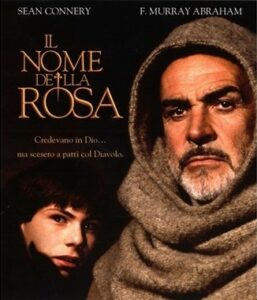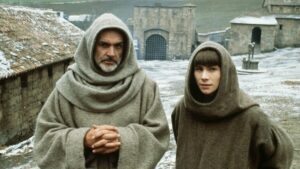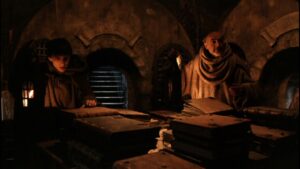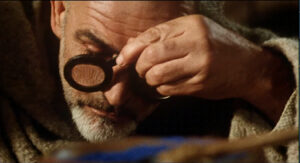“The Name of the Rose” – in the Labyrinth of Book Culture

Title: “The Name of the Rose”
Release Date: 1986
Director: Jean-Jacques Annaud
Cast: Sean Connery, Christian Slater, Michael Lonsdale, F. Murray Abraham, Valentina Vargas
“The Name of the Rose” by Jean-Jacques Annaud is a great adaptation of Umberto Eco’s literary masterpiece. At the author’s request, the film was made in English as “the Latin of the modern world”. Based on a crime pattern, it’s a fascinating story set in the realities of the Middle Ages, which hides a metaphorical message about European culture beneath the plot. Namely, it appears as a space of encrypted signs, such as a monastery, a cathedral or a library, which are significant symbols that build the collective identity of the people of the Book.
“The Name of the Rose” – a crime in a Benedictine monastery
The events depicted in “The Name of the Rose” take place in a 14th century Benedictine monastery, where two Franciscans arrive: William of Baskerville and his young disciple Adso of Melk. The men’s visit is no coincidence, for there has been a mysterious and horrifying crime against a young monk in the abbey, and Brother William, famous for his detective sense, is to help solve the mystery. During the Franciscans’ stay at the monastery, more murders occur, and with each passing day the threat of turning the case over to the Inquisition grows. So when a representative of the Holy Office finally shows up, it is clear that this will do no good, and soon the stakes will be lit.
Annaud’s masterful adaptation
“The Name of the Rose” by Jean Jacques Annaud is a fascinating picture of the medieval world with all its contrasts. So, on the one hand there are the ascetic monastery, the strict rule of monastic life and poverty, and on the other, debauchery and crime. Superstition and obscurity sit side by side with reading, erudition and unparalleled knowledge, and mortification of the body functions in parallel with the indulgence of various erotic needs. It is precisely this ambivalence of the Middle Ages as the chief characteristic of this era that is brilliantly captured by the director. “The Name of the Rose”, in fact, does not reproduce the myth of widespread mental backwardness and asceticism, but emphasizes aspects often overlooked in the colloquial image of those times, namely the existence of an intellectual elite and a natural attitude to the body.

One might even think that these two “bright” sides of the Middle Ages are embodied on some level by the two main characters. For Sean Connery’s excellent portrayal of William is the embodiment of reason and the primacy of science. Christian Slater, on the other hand, as a somewhat naive, but sincerely loving young man to his master, is a man guided by intuition, the inner voice of the heart and passion. What’s more, at the end it will turn out that the young hero will have to make a choice between these two paths, and at the end of his life he will come to think once again about its rightness.
As a portrait of the Middle Ages, the film “The Name of the Rose” has been refined down to the smallest detail. Indeed, the world depicted is a mirror of medievalist ideas. Thus, the space is organized by the scenery of a gloomy monastery and a huge library. The peculiar technique of filming scenes from below (the so-called insect perspective) emphasizes the conviction of human smallness and insignificance, characteristic of the Middle Ages, which of course contrasts with the monumentalism of the sacred buildings. The film’s color scheme, with its predominance of gray and shades of blue, conveys a cold and bleak picture of the world, which is enlivened only by the flame of fire (in the erotic scene) and the red of blood (in the shots of the denizens and the inquisitors’ outfits). Here, too, therefore, there is a contrast.
In turn, the images are associated not only with the Middle Ages themselves, but are a reference to all the eras in which the prevailing mental currents of that time prevailed, especially Baroque and Romanticism. In the method of using chiaroscuro, for example, one can see the influence of Rembrandt’s painting, bringing significant figures out of the darkness with the help of light, which at the same time gives them a clear ethical character.

“The Name of the Rose” and the Book’s ambiguous symbolism
Perhaps the most interesting thing about “The Name of the Rose,” however, is how the medieval world depicted corresponds with the present day. For there are undoubtedly figures crucial to the whole of European culture. Those most prominently featured are the monastery and cathedral functioning in the popular consciousness as an allegory of the Middle Ages. These buildings reflect the worldview of the time – a focus on eternity and spiritual values. The cathedral is one of the cornerstones of the division of the world into the sacred and the profane, and continues to function in this form today.
Nevertheless, the interior of the monastery also hides a huge multi-story library, housing a hundred different rooms. It symbolizes all human knowledge, which is considered by the abbot as something dangerous and leading the brothers into temptation. This is why only a few have access to the library, and those who possess too many of its secrets must perish. It is no coincidence that the library in the film “The Name of the Rose” is housed in a tower and has a gradational structure. It clearly resembles the biblical Tower of Babel, which people built in order to ascend to heaven and match God himself. It’s hard not to see Umberto Eco’s reference here to Jorge Luis Borges’ famous short story “The Library of Babel.”
In turn, the fire of the huge book collection brings to mind a dramatic historical event: the destruction of the largest Library of Alexandria in the ancient world. At that time, the greatest treasures of European ancient literature disappeared irretrievably, including the famous third book of Aristotle’s “Poetics” devoted to comedy. It is this work that turns out to be the cause of all the crimes in the monastery.
All the figures mentioned: the monastery, the cathedral and the library belong to the cultural sphere, and they are united by their labyrinthine nature. Secret passageways, dark alleys, a multitude of corridors, cells and chambers – all this creates a puzzling, dangerous and at the same time demanding activity. The foundation of these institutions, on the other hand, is the Book – in the case of the cathedral it is the Bible, in the library this mythical role is played by Aristotle’s lost “Comedy”. Therefore, if we treat “The Name of the Rose” as a metaphorical image of European culture, it appears as a system of encrypted signs, the meaning of which is explained to us by sacred books. After all, the author of the original film is none other than Umberto Eco – a well-known academic semiotician.

“The Name of the Rose” – the laughter of truth
Contrary to appearances, however, “The Name of the Rose” does not offer simple and unambiguous solutions to age-old human dilemmas. On the contrary, it shows that a person can get lost both in the maze of monastery corridors and between the shelves of books full of wisdom. Both extremes give rise to very dangerous consequences: a warped understanding of religion leads the Inquisition to murder the innocent, while ascribing too much authority to science leads to crimes out of fear of its, appropriation. Therefore, recalling these events many years later, Adso concludes that “Perhaps the task of one who loves people is to arouse laughter from the truth, to make the world laugh, for the only truth is to gain knowledge of how to free oneself from an unhealthy passion for truth (…)”.
The most dangerous attitude, then, seems to be the belief in our own infallibility, which gives us the supposed right to make others happy by force. No one owns the truth – we are all doomed to search for it in an infinite system of signs, each of which links to the next. The ethics of the cognitive process, on the other hand, requires distance and humility in the face of the impossibility of its ultimate completion. This is a philosophy emblematic of Umberto Eco as the author of “Lector in fabula”, where he articulated his famous theory of the model reader. Well, according to the writer, any interpretation requires from the viewer a certain ethical responsibility towards the literary work, which imposes limitations on him and does not allow him complete freedom.
“The Name of the Rose” – “the names of only mothers”
Adso ultimately does not follow his heart, despite the warnings of his old experienced brother, he chooses the cool intellectualism of his master, rejecting the affection of the girl who loves him. However, it is she who gives the ultimate meaning to the whole story, and it is her supposed name that he invokes at the end of his life. “Now that I am an old, old man, I must confess that of all the faces that appear to me out of the past, the one I see most clearly is that of the girl of whom I’ve never ceased to dream these many long years. She was the only earthly love in my life, yet I never knew, nor ever learned, her name.”
The movie ends with the Latin maxim: “Stat rosa pristina nomine, nomina nuda tenemus” – “The old rose persists in name, names only we have“. So we try to describe the world with different sign systems, because we are immersed in the culture of the Book, but we will never be able to fully decipher the mystery, just as Adso never learned the name of his beloved.
Literature:
„Kino końca wieku”, pod red. T. Lubelski, I. Sowińska, R. Syska, Kraków 2019.
A. Burzyńska, M. P. Markowski, „Teorie literatury XX wieku”, Kraków 2006.
